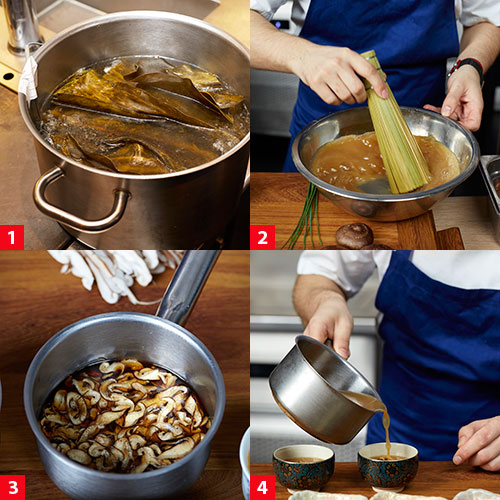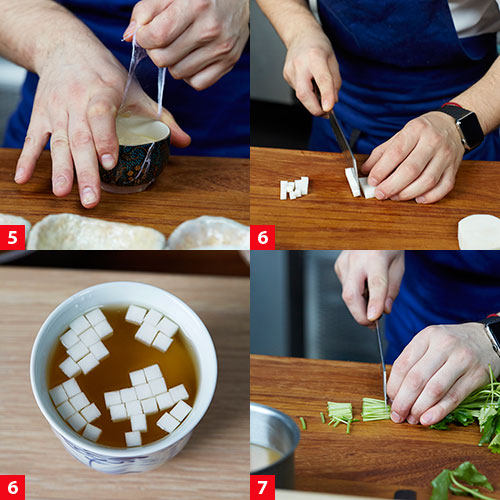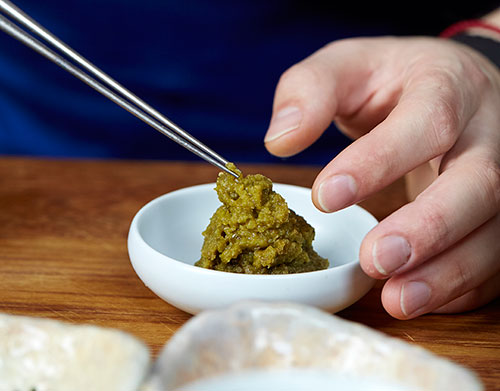Masterclass: Chawanmushi by Alexandru Craciun at Sosharu
Chawanmushi is a staple in Japan, eaten everywhere from home-style cafés to high-end restaurants. It's also a part of the multi-course meal at Jason Atherton's new restaurant, Sosharu, where it's presented with a host of Japanese flavours. Michael Raffael reports
Chawanmushi sounds like it's packed with eastern promise. It translates as "steamed tea bowl", a description that tells how the dish is prepared and presented without letting on that it's a kind of egg custard. It's a blend of beaten egg and dashi (Japanese broth), with the texture of the finest tofu, akin to a traditional British junket.
In Japan it's as popular as, say, quiche is in France. Small family-owned eateries specialise in it, but it also features at kaiseki, the multi-course meal served at luxury restaurants.
The egg custard itself acts as a kind of foundation. How good it tastes will depend on the quality of the dashi that supplies the umami fix essential to the final taste.
Kisetsu is a countertop restaurant-within-a-restaurant at Sosharu, Jason Atherton's most recent London venture. Here, executive chef Alexandru Craciun prepares chawanmushi to order in front of customers. Kisetsu means ‘season', and the version he prepares uses ingredients, whether they are sourced locally or imported from Japan, that are at their peak.
Planning
- Prepare the egg/dashi mixture
- To order: put the crabmeat and marinated mushroom in the bowl and steam with the egg mixture.
- Finish with sea urchin, mushroom, mitsuba, chives, pickle jelly, yuzukoshÅ, grated lime zest, Tokyo turnip and grated wasabi.
Dashi
There are three main kinds of dashi: a vegan one, a fish one and a simmered, stronger one. Sundried kombu - kelp - is the basis of all of them. There are several varieties, each one with its own flavour profile. Up to 90% of the seaweed comes from the northern island of Hokkaido. Craciun uses a variety called rishiri that's sweet, saltier and harder than the more common Ma.
For chawanmushi containing crabmeat and topped with sea urchin, Craciun prefers the classic ichiban dashi containing bonito (dried skipjack tuna) flakes.
(For more information on kombu, go to www.kurakonusa.com/kombu)
- 10g kombu
- 1 litre water
- 15g bonito flakes (sometimes labelled as katsuobushi)
- Soy sauce to taste
Wipe the kombu thoroughly with a damp cloth. Put it in a pan with cold water and heat slowly to a temperature just below boiling point, 89°C.
Remove the kombu. Add the bonito flakes and bring to the boil. Turn off the heat, leave it to stand for a minute and then skim any scum that has floated to the surface. Strain into a clean pan and season with soy (1).
To make a stronger dashi for the mushroom marinade, use the same proportions as above but put all the ingredients in the pot together, bring to the boil and simmer for 10 minutes before skimming and passing. This produces a darker, richer stock.
Chawanmushi base
To make eight portions
- 500ml dashi, cold
- 150g whole egg
Whisk the ingredients together until they blend and pass through a fine sieve (2).
Marinated shiitake mushrooms
The quantity of strong dashi given below is sufficient to marinade about 10 mushrooms. The recipe uses one organic shiitake mushroom per serving.
For 10 mushrooms
- 15g fresh ginger, finely julienned
- 500ml strong dashi
- Shiitake mushrooms, finely sliced
Combine the ingredients in a small saucepan and bring to the boil. Take off the heat and leave for at least 20 minutes to settle (3).
Kisetsu's chawanmushi
Serves 1
- 3 rounded tsp marinated and drained shiitake mushrooms
- 50g white crabmeat
- 80ml (approximate) chawanmushi base
- 1 slice of round Tokyo turnip, about 3mm thick
- 4-5 Mitsuba stems (Japanese wild parsley)
- Chopped chives
- Fresh wasabi
- Yuzukosho¯ paste
- 1 scant tsp amasuzuke jelly, diced
- Grated lime zest
- 1 fresh sea urchin
Put two teaspoons of the mushrooms and 40g of the crabmeat in the teabowl. Pour over the chawanmushi base (4). It won't reach the top of the bowl. Cover the top with cling film. Steam for 10-12 minutes at 89°C. Remove the cling film (5).
While it's steaming, trim the edges of the turnip and dice into small cubes (6). Cut the mitsuba stems the same length as the chives - a little less than a centimetre long (7). Grate the wasabi root (Craciun uses a sharkskin-based grater) (8).
Put the rest of the mushroom and crabmeat on the set egg custard. Add the mitsuba and chives. Use chopsticks or tweezers to put the turnip around them and then add one or two small dabs of wasabi and yuzukoshÅ. Carefully add the cubes of jelly (9). Grate a little lime zest over the surface and finish with the sea urchin. Serve with a wooden spoon (10).
Tip
Here the custard is served still warm, but in summer you can prepare a small batch, chill it, and serve it cold.
Jason Atherton on costing
"A lot of big organisations will take on a chef and expect them to be masters of costing when all they want to do is cook. I've an accountant to do that, and I send him in to cost all the dishes and check whether the chef is getting the best produce at the best price.
"We give young chefs that support so they have a platform to do what they can do best -work in the kitchen, dishing up amazing food, instead of sitting in an office."
Umami and kokumi
Most chefs have got their heads around the concept of umami as the fifth flavour, enhancing taste, helping to balance sweet, sour, salty and bitter tastes, and adding an extra depth to the way we experience food.
Now, it seems, there's another newly identified taste - kokumi. This is the initial hit when food goes into the mouth, sometimes translated as 'heartiness' or 'mouthfulness'.It's a sense of richness in food and the length of time the flavour stays in the mouth.
The better the quality of a dashi, the more umami and kokumi it will bring to a dish.
Yuzukosho
This is a powerful paste made from green chillies (Thai or Japanese togarashi peppers) and yuzu zest, the citrus fruit characteristic of many Japanese recipes.
Grind three seeded Thai chillies with the grated zest of six yuzu. Pound in a mortar with a little coarse salt until smooth. This paste can be made in larger quantities and stored in the fridge in Kilner jars for several months.
Amasuzuke pickle
This is a sweet and sour fresh pickle similar to the Western kind used with dill cucumbers. To make it, boil one litre of rice vinegar with 50g sugar, 10g salt and ground white pepper.
For the chawanmushi recipe, the fresh pickle is set by dissolving fresh gelatin in it.
Sosharu's crab salad
In contrast with the refinement and fine-tuning that can be seen in Kisetsu's chawanmushi, Sosharu's menu, which is more in the style of a Japanese-style bistro, is more robust and includes this crab salad.
Serves one
Spoon a tablespoon of jellied amasuzuke pickle onto the base of a shallow serving bowl. Cut a thick disk of iceberg lettuce, quarter it, and lay it on the jelly.
Pipe a chilled crab bisque flavoured with yuzu and lemongrass on top.
Sprinkle flaked crab and edamame beans over the lettuce. Finish with toasted onion seeds and black and white sesame seeds, and garnish with radish slices.
Jason Atherton and Alexandru Craciun
Jason Atherton's expanding portfolio of restaurants stretches from New York to Shanghai. No two are alike, making him a creative restaurateur rather than a star chef trading on his reputation.
To succeed doing it his way, he relies on two key things: one, he says, is internal promotion within his group: "I've a certain mindset and people who work for me know what I expect. They know me as a no-bullshit guy who always delivers the goods, come rain or shine, and if they're not on that train, I don't want them."
The second lynchpin, he believes, is giving his executive chefs a stake in the business: "They put their professional lives on the line. If they fail, they lose a six-figure salary and a share in the company, but they also lose their dream."
After spending several years with Atherton at Pollen Street Social, Alexandru Craciun asked his boss for support for a study trip to Japan. He worked as a stagiaire at the three-Michelin-starred Murato in Kyoto, returned to the UK, and then went back again and stayed for a year, working in family restaurants and studying food at university.
At the time, Atherton had no concrete plans to open a Japanese restaurant. Six months before opening Sosharu, he found a property in London's Clerkenwell that was suitable for an izakaya (Japanese gastropub) and asked Craciun to be its executive chef.
According to Atherton, it was the first time he had not written an opening menu: "Alex's input was 80% and mine the rest. I tasted and re-tasted the dishes and advised on how to relate them to Western palates. I didn't want to shock customers by making it too hardcore."
Kisetsu is a small luxury restaurant within Sosharu, open in the evenings. Craciun does all its cooking. It allows him to cook bespoke dinners to order in front of a handful of customers. Yes, he admits, it is uncompromising classic Japanese cuisine, created with all its subtlety, refinement and attention to detail. He isn't afraid, though, to put his own personal stamp on it.
Continue reading
You need to be a premium member to view this. Subscribe from just 99p per week.
Already subscribed? Log In

















